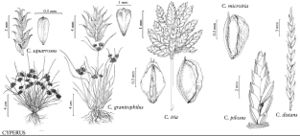Cyperus granitophilus
Castanea 2: 103, figs. 4–8. 1937.
Herbs, annual, cespitose, with roots fibrous. Culms trigonous, glabrous. Leaves V-shaped to flat, (2–) 4–11 cm × 3–4 mm. Inflorescences: rays absent; bracts 2–4, ± horizontal, flat, 1–6.5 cm × 2–3 mm; rachilla persistent, wingless. Spikelets 10–40, compressed, ovoid to linear-lanceoloid, quadrangular, 5–9 × 2–3 mm; floral scales deciduous, 5–20, spreading, pale greenish to reddish-brown, laterally (5–) 7–9 (–13) -ribbed, ovate, 3–4 × 1–2 mm, apex straight, excurved mucronate, or cuspidate. Flowers: stamens 1–2; filaments 1.5 mm; anthers 0.8–1 mm, connective apex reddish yellow, less than 0.1 mm; styles 0.8–1 mm; stigmas 1–1.2 mm. Achenes brown to reddish-brown, broadly ellipsoid to obovoid, 0.8–1.2 × 0.5–0.6 mm, base ± cuneate, apex truncate-obtuse, surfaces puncticulate.
Phenology: Fruiting summer.
Habitat: Thin soil over outcrops of granite or sandstone of the Piedmont and inner coastal plain
Elevation: 50–400 m
Distribution

Ala., Ga., N.C., S.C., Tenn., Va.
Discussion
Cyperus granitophilus is documented as an autotetraploid derivative of C. squarrosus (L. W. Garoni and W. H. Murdy 1964).
Selected References
None.
Lower Taxa
"shortened" is not a number.
